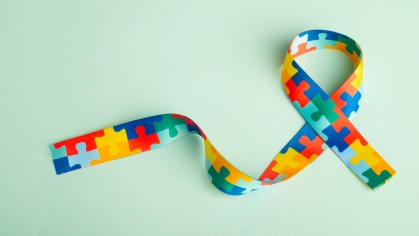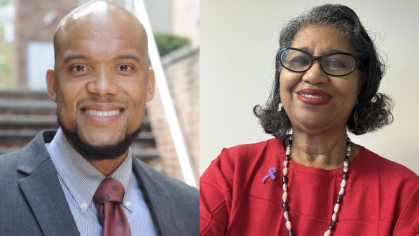Domestic Violence Awareness Month takes place every October. Simone Snyder, Senior Program Coordinator at Rutgers School of Social Work’s Center for Research on Ending Violence, discusses the importance of recognizing Domestic Violence Awareness Month and shares ways social workers can recognize it this month and beyond.
Tell us a bit about your journey to social work.
My pathway to social work was a gradual, yet synchronistic one. I studied anthropology and gender studies as an undergraduate, and a few years after graduating, I became a doula, childbirth educator, and homebirth midwifery assistant. It was that work that introduced me to the field of interpersonal violence. I found myself working with pregnant people who had experienced some type of trauma in their lives, usually in the form of domestic or sexual violence and at that time, no trainings existed for doulas on how to support survivors throughout pregnancy and the postpartum period. I took it upon myself to start volunteering at domestic violence agencies and rape crisis centers to learn how to support my clients. When I finally moved back to New Jersey, I applied for a dating violence prevention educator position at Jersey Battered Women’s Services. That position changed my life. During that time, I met a Rutgers MSW intern who was enrolled in (what was then) the Violence Against Women and Children Certificate program. I had been considering enrolling in midwifery school up until that point, but there was something calling me to social work and, in particular, to this program at Rutgers. I realized that this path would allow me to integrate my birth justice work with social work, creating an impact that would extend far beyond my individual practice.
What is the significance of Domestic Violence Awareness Month for you?
For many years, domestic violence was a private matter that no one talked about, and as you can imagine, had a significant impact on survivors. For me, Domestic Violence Awareness Month (DVAM) is about raising awareness and increasing the public’s understanding of domestic violence and its many forms. It is about taking it out of the private sphere and into the public. It is also about empowering survivors and centering their experiences and reminding them that they are not alone. It is about promoting prevention, intervention, mobilizing communities and committing to systemic change. For me, personally, it is about raising awareness about the root causes of domestic violence and how it intersects with other issues like gender inequality, housing, and economic justice. A few years ago, in response to my son’s football team wearing pink for Breast Cancer Awareness Month (also in October), I petitioned the league to wear purple armbands and purple ribbons on their helmets to raise awareness about domestic violence. I shared statistics and resources about why I thought this was important, and I am proud to say that they are still carrying on the tradition – even after my son graduated from the program. There was little to no awareness about domestic violence within this community and by engaging in this campaign more people are learning about the issue.That is what DVAM is about – raising consciousness and demanding change.
How can the social work community recognize and commemorate Domestic Violence Awareness Month?
There are so many ways we can get involved in DVAM. Each of the Violence Prevention and Victim Assistance (VPVA) offices here at Rutgers will host events and programming (be on the lookout for “Turn the Campus Purple”) that we can attend or encourage our students to attend. Every October, the New Brunswick Domestic Violence Awareness Coalition hosts an event. This year the 22nd Annual March & Rally Against Domestic Violence will take place on Saturday October 5th St. Joseph’s Church, which is located at 293 Somerset Street in New Brunswick (at the corner of Somerset Street and Maple Street). The Center on Research for Ending Violence (REV) will participate in Purple Thursday on October 17th (details to follow). Purple Thursday, celebrated on the third Thursday of October, is a day where people wear purple to show their support for survivors of domestic violence and is a way to get the whole school involved.
Other ideas for recognizing and commemorating DVAM include hosting workshops and seminars on domestic violence prevention, trauma-informed care, and support strategies for survivors. The social work community can also partner with community organizations to launch awareness campaigns. This can include sharing information about domestic violence on social media, distributing resources, or organizing public events to raise awareness. Social work programs and agencies can collaborate with domestic violence shelters, rape crisis centers, or legal aid organizations to provide pro bono services or additional support during DVAM. We can also find out what kind of mutual aid initiatives are available in our communities and offer our support there. Of course, it is also important to engage in advocacy efforts to push for stronger protections for survivors, increased funding for services, and better training for folks engaging with survivors.
Social workers can use DVAM as an opportunity to engage in professional development like we offer at REV, seeking out specialized certifications or training in domestic violence counseling, safety planning, and crisis intervention. Many of us that are engaged in restorative justice, transformative justice, or even abolitionist social work can use this time to talk about what that means in the context of domestic violence.
As practitioners, researchers, and educators engaged in social justice work, we are in a unique position to be able to shape the response to domestic violence and to figure out ways to grow and adapt in how we respond to the issue.
What can the social work profession or social workers do to continue to support those facing domestic violence beyond this month?
Most of what I already mentioned does not need to be limited to the month of October. I think integrating domestic violence education and awareness raising into daily practice is key. Social workers can ensure they are constantly educating clients, colleagues, and communities about the dynamics of domestic violence, healthy relationships, and available resources throughout the year. Incorporating this into regular practice ensures that awareness and prevention are not limited to one month.
Advocacy efforts and partnership building should continue beyond DVAM. Social workers can also join or form coalitions that advocate year-round for the needs of domestic violence survivors. Most importantly, social workers can work to form sustained partnerships with domestic violence agencies, coalitions, and advocacy groups to ensure that they are able to stay informed about best practices and community needs. By collaborating regularly, they can provide holistic support to clients and build stronger referral networks. Knowing the resources in the community, both formal and informal, is invaluable.
I also believe that we should be promoting policies within our workplaces that protect employees from domestic violence. This includes advocating for domestic violence leave policies, safety protocols, and mental health support for affected folks.
By maintaining these efforts year-round, social workers play a critical role in keeping the momentum of DVAM alive and addressing domestic violence in a meaningful, sustained way.
At the end of the day, social workers can be integral in creating transformational change in the field of domestic violence through leadership in response, intervention, and research, advocating for survivor-centered policies, advancing trauma-informed care, developing evidence-based practices that shape more effective prevention and support systems, and centering the experience of survivors in the work.
For anyone interested in learning more or if they need support please visit:
- The National Hotline: https://www.thehotline.org/
- New Jersey Coalition to End Domestic Violence: https://njcedv.org/
This story was created in partnership with Rutgers School of Social Work's Inclusion, Intersectionality, Diversity, Equity, and Advancement (IIDEA) Committee.



